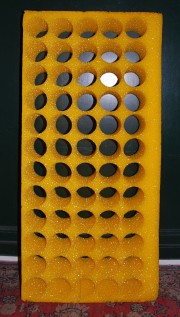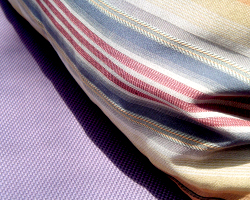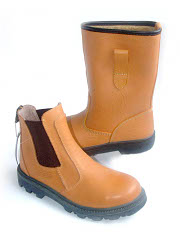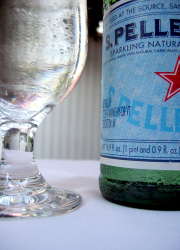 Polly has emailed us with a Compost This question:
Polly has emailed us with a Compost This question:
Can I emptied my hoover bag into my compost bin? I know you can compost dryer lint so wondered if it was the same.
Like with tumble dryer lint, it depends what the lint/dust is most made up of – but most of the time the answer would will be yes. The contents of your vacuum’s bag/canister tends to made up of dirt brought in on shoes (compostable), human/pet hair (compostable), human/pet skin skin cells (compostable) and, depending on how tidy you are when you eat, food crumbs (compostable). Probably the biggest thing to be wary of is if your carpet sheds a lot of fibres – if it’s a synthetic carpet, you don’t want to add that to your compost really but if it’s natural fibre (such as wool), then it’s fine.
You should to take to mix it well into your existing compost – that’ll both add moisture to the dry dust (and help start the composting process) and stop it being a suffocating layer on the top. Because everything is in pretty small particles anyway, some people say you can skip the compost stage and just dump it straight onto your garden – again though, dig it in or the dust will just blow around when you get the slightest breeze.
Any other advice? Or other suggestions?
Categories: garden, household, items
Posted by louisa
on 22 March 2010
 We’ve had an email from Petra:
We’ve had an email from Petra:
From a party project, we have left two big foam “things” with holes in it. See the picture included. They measure 108 by 47 by 18 (in centimeters). The holes are large enough to hold a winebottle. But the foam is quite soft, so it’s not safe enough to make it into a hanging wine rack.
I thought about it being playing items for the kids in the garden, but any better ideas are more than welcome.
The bright colour, softness and chunkiness make them feel very much like something for kids – one of those things that if we’d had it as a kids, we’d have come up with a thousand different play uses for it. If you have a few, another kid-related thing might be to string them up as hanging dividers in a bedroom – such as between the sleeping area and the playing area, or to give kids a little privacy/sense of their own space in a shared room.
Aside from that, if you could find boxes big enough to hold them (under bed storage boxes maybe?), they might be useful for keeping glasses or bottles safe during a house move (if you’re not moving, someone on Freecycle probably will be!).
They also could be useful in the garden if you’re growing a lot of seedlings – holding plant pots upright when they start to get a bit top heavy or if it’s windy.
Any other suggestions?
Categories: garden, household, items, packaging
Posted by louisa
on 19 March 2010
 When we moved into our new house last autumn, we got a new bed.
When we moved into our new house last autumn, we got a new bed.
Despite our love of slumber, our last bed was awful – the cheapest double I could find when I needed a bed in a hurry back in 2002. It was small, uncomfortable and had been repaired so many times, I think by the end it was made out entirely of glue and hope, not badly laminated wood.
When we moved here, we decided to do things right – after looking at the options in all the big bed shops and online, we ended up commissioning a local furniture maker to make us a bed frame instead*. He made it out of reclaimed wood (yay recycling!) and to a chunky design of our choosing. When he came to assemble it, he gave us a little tool which we might have to use to tighten some bolts — in twenty years time. It’s the best, most solid bed I’ve ever met and we’re very happy with it.
Why am I telling this story in a post about sheets & bed linen? Well, because we decided that after getting the bed frame right, we were going to get the rest of our bed experience spot on too. Like with the bed itself, we decided to buy good quality items that would last us for years and years, instead of cheap things that would fall apart – a key part of “reducing”. I spent ages tracking down & more money than I would normally do on bed linen to get top quality 100% cotton duvet covers. And you know what? Both have ripped already.
We think one of them got ripped on our cat Carbon’s last day – sadly, I can imagine him using the duvet to claw his way onto the bed, or using his claws to drag himself around the space once he was up there. There is a straight tear in it about four inches long, and some smaller tears & L-shaped tears in other spots too. The other duvet cover? I’ve no idea how that got ripped. I just found an L-shaped tear in it – about four inches on either side – when I was washing it the other day. Whatever happened though, it needs fixing.
So what is the best way to repair these supposed-to-last-years duvet covers? Will something like iron-on mending tape work? Or would good old-fashioned sewing be better – and if so, any stitch/method recommendations? Or would patching them be a better route in the long run? Any advice on doing that neatly and smoothly?
Any other suggestions?
* In case anyone’s interested, it was
Stump Furniture in Leeds. It wasn’t exactly cheap but it was the same price as the one we were looking at in a brand-name bed shop — and that brand-name bed was allegedly half the price it should have been. I doubt that shop one would have been so well made.
(Photo by uvo_design)
Categories: clothes and fabric, household, items, repair this
Posted by louisa
on 18 March 2010
 We’ve had an email from Gordon:
We’ve had an email from Gordon:
I am looking for a company that recycles or reuses used safety boots and shoes. They are predominantly leather with a steel toe cap and rubber or manmade sole. As a [huge multinational] company you can imagine we have quite a few and at present they go to landfill.
Do you know of any businesses that would be interested?
I suspect like happens with hard hats, they’re having to be replaced for health & safety reasons – they’ve become too worn/damaged to wear in a dangerous industrial environment.
If these boots have been retired for safety reasons, further reuse by someone else is largely out of the question – they might be fine for someone to use for light DIY or gardening etc but I wonder if there would be a liability issue if a company was to pass them on for that sort of thing…
It’s pretty easy to find a textile recycling/reclamation company but harder to find down ones that explicitly ask for leather, let alone safety footwear. Anyone know any companies that specifically deal with these types of boots or leather in general?
Any other suggestions?
Categories: clothes and fabric, items
Posted by louisa
on 17 March 2010
 We’ve had an email from Jennifer asking:
We’ve had an email from Jennifer asking:
I was on the verge of buying a soda siphon to make my own sparkling water at home – surely much more ecologically sound than buying bottled sparkling water, right? But my husband raised a concern about the used CO2 cartridges? Are they recyclable?
A not-so-quick Google around suggests that they’re metal (typically steel) so can be recycled with normal metal recycling. Anyone know for sure?
When we posted about water filter cartridges three years ago (cor! that’s ages!), we had a number of people making reuse suggestions – how to clean them to get more life out of the filters – are there any tricks like that for soda syphon cartridges?
Even if they couldn’t be reused or recycled though, it still might be worth considering the syphon route because of the amount of energy wasted shipping heavy bottles of water around the place.
Any other suggestions?
Categories: food, items, kitchen, packaging, water
Posted by louisa
on 16 March 2010
 Polly has emailed us with a Compost This question:
Polly has emailed us with a Compost This question:


 We’ve had an email from Petra:
We’ve had an email from Petra: When we moved into our new house last autumn, we got a new bed.
When we moved into our new house last autumn, we got a new bed. We’ve had an email from Gordon:
We’ve had an email from Gordon: We’ve had an email from Jennifer asking:
We’ve had an email from Jennifer asking:














